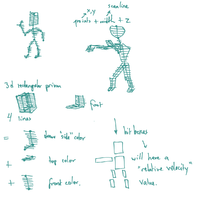ible
professional vim user
@makapuf
ok, that makes sense. it should be super easy to code it up as a u32, at least for the standard case (when the whole sprite is onscreen).
the null nibble is specific to each sprite. each sprite can choose which color of the palette is invisible for them; that way you can have sprites which have different "palettes". i suppose it's not a huge advantage.
sounds good for the pointer being bufferX + 16. if the whole buffer is aligned on 1024 (on 16-bit increments?) not sure if it makes memory access less efficient, but it would make it easier to use!
ok, that makes sense. it should be super easy to code it up as a u32, at least for the standard case (when the whole sprite is onscreen).
the null nibble is specific to each sprite. each sprite can choose which color of the palette is invisible for them; that way you can have sprites which have different "palettes". i suppose it's not a huge advantage.
sounds good for the pointer being bufferX + 16. if the whole buffer is aligned on 1024 (on 16-bit increments?) not sure if it makes memory access less efficient, but it would make it easier to use!


